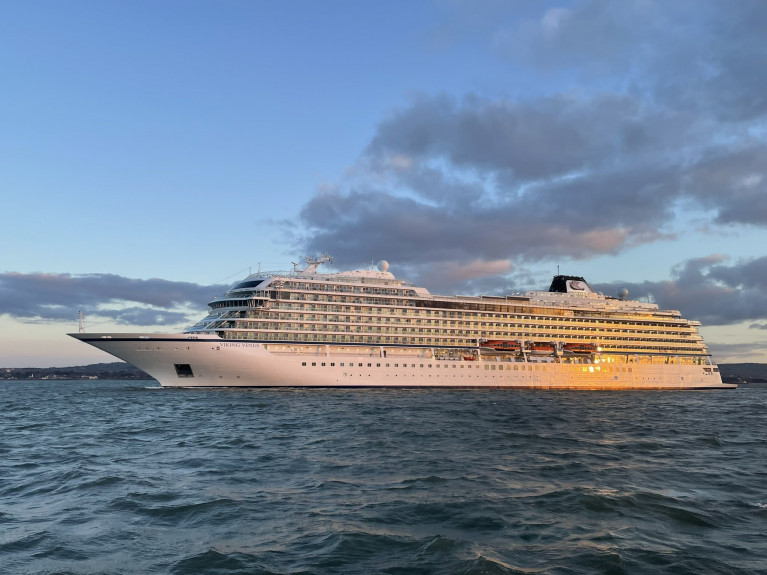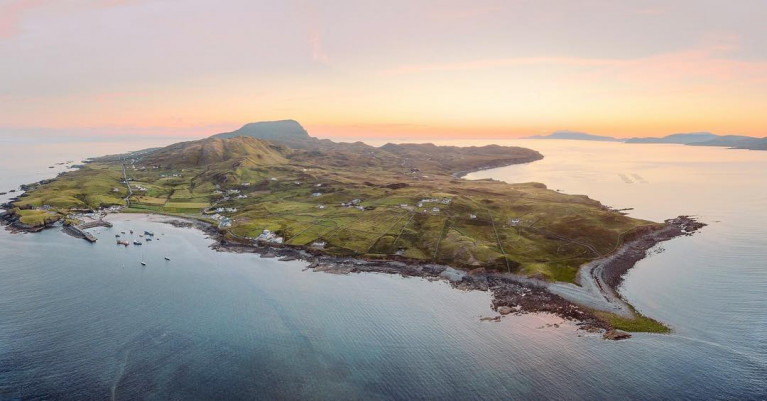Displaying items by tag: Tourism boost
Tourism Boost to Ireland as Brittany Ferries' New Season Commences With Roscoff Route Resuming
Brittany Ferries marks the start of the tourism season with the first sailing of Armorique to the Port of Cork today.
The 30,000 ton, 1500 passenger cruise-ferry had sailed from Roscoff, Brittany and arrived at Ringaskiddy at 09:30 this morning with 330 holidaymakers on board.
The return sailing to the Breton port departed at 1600 on the Ireland-France route which Afloat adds is Brittany Ferries only 'seasonal' operated service.
Armorique will make the call into Cork every Wednesday between now and November, and will be joined on the Cork/Roscoff route from 1st April by Brittany Ferries’ 42,000-ton 2,400-passenger flagship Pont-Aven which will visit Ringaskiddy each Saturday from 11:00-16:00.
Anticipating a busy season ahead, Brittany Ferries bookings already exceed this time last year, with a 34% increase on all routes from Ireland to France and Spain.
In addition, Brittany Ferries has seen a 29% increase in the number of passengers travelling between France and Ireland versus this same period last year, almost half of which are French natives visiting Ireland.
Hugh Bruton, General Manager of Ireland with Brittany Ferries stated, “We are delighted to once again mark the start of a new season. The growing passenger booking numbers show us that 2023 is going to be a boom year for travel both into and out of Ireland. Despite inflation and the current economic climate, passengers want to travel and escape this year and will make things work to do so. Ferry travel offers so many benefits – including avoiding lengthy airport queues and the option to have your car to explore your destination with ease. We are so pleased to see numbers returning close to pre-pandemic levels at last.”
Brian O’Flynn, Fáilte Ireland stated, “A welcome sight each Spring is the Brittany Ferries’ ships sailing in and out of the harbours of Cork and Rosslare. Brittany Ferries carry thousands of tourists to Ireland each season, offering a boost to local economies, tourism and trade. It is so positive to see an increase of 40% in French passengers visiting Ireland this season and we look forward to welcoming them.”
Now offering a twice-weekly service connecting Cork with Roscoff in western France, as well as direct routes from Rosslare to Le Havre, Cherbourg in France and Bilbao in Spain, Brittany Ferries offers a variety of destinations and unparalleled comfort on its fleet of modern ships.
The newest vessel of the fleet, Salamanca, which launched late last year on the Rosslare to Bilbao and Cherbourg routes, is a state-of-the-art cruise-ferry and is the first LNG-powered passenger ferry to regularly operate from Ireland.
Roscoff to Cork sailings run twice weekly, on the Armorique and the flagship vessel Pont-Aven, from March to October 2023.
First Cruise Ship to Belfast Harbour of 2022 Arrives As Tourism Industry Anticipates Bumper Holiday Season
The first cruise ship to Belfast Harbour for the 2022 season arrived on Friday, with the tourism industry anticipating a bumper season after taking a massive hit from Covid-19.
The Viking Venus, a 930-passenger vessel owned by Viking Cruises, is the first of 130 cruise ships expected to bring up to 340,000 visitors to Belfast in 2022.
Belfast is a stop on Viking Cruises’ 15-day voyage between London and Bergen in Norway (which included a tender call of Dun Laoghaire Harbour)
Belfast Harbour said 18 of the cruise ships would be first-time visitors, and many would visit on multiple occasions. In total, there are 50 vessels from 33 cruise lines due to arrive.
Newcomers include the Ambassador Ambience from British cruise line, Ambassador, and Princess Cruises’ Enchanted Princess and Island Princess.
Michael Robinson, Belfast Harbour’s port director, said: “Following two challenging years for tourism, the team at Belfast Harbour is thrilled to have 130 cruise vessels booked for arrival at our port in 2022.
Further coverage the Belfast Telegraph reports.
Increased Sailings Confirmed for Clare Island Ferry Service
Deputy Alan Dillon, Fine Gael Spokesperson on Tourism & Sport, welcomed confirmation from Rural & Community Development Minister, Heather Humphreys TD, that her Department will be increasing daily ferry sailings to Clare Island.
A tender recently issued by her Department only required a minimum of two return services daily. This meant that something as simple as a medical appointment might require an islander having to sacrifice an entire day to travel to the mainland.
The ferry service will now be increased to four return sailings daily, which should prove a real game changer for people living on the island. In addition to increasing tourism opportunities.
More here reports Mayo Advertiser that follows a campaign by islanders to improve the service
Tourism High as Ship Visits to Belfast Hit New Record
#RecordCalls - A new tourism high as almost 90 cruise ships are expected to visit Belfast Harbour this summer, bringing with them 150,000 passengers and crew to the city.
Belfast’s record cruise schedule for 2017 marks an unprecedented period of growth for city tourism and investment which has underlined the city’s soaring appeal among cruise tourists from around the world but particularly the UK, Europe and North American markets.
Belfast has established itself as a destination of choice for cruise operators and visitors, becoming the second busiest port of call in Ireland and once again attracting more cruise passengers than Liverpool in 2017.
By the end of this year, almost 600 cruise ships will have visited the city since the first arrival in 1996.
This year, 88 ships are scheduled to arrive with the first arrival – the Marco Polo due on April 21., while Princess Cruises, one of the world’s leading cruise operators, which operates the giant 4,600-passenger and crew capacity Caribbean Princess has strengthened its commitment to Belfast scheduling a record 14 stops this year.
Delivered by Cruise Belfast partners Belfast Harbour and Visit Belfast since 1999, cruise tourism has been a major city success story. It is also an increasingly important part of the city’s tourism mix, along with city breaks and business tourism.
Full details of the cruise schedule are available on Cruise Belfast’s website here and Belfast Harbour’s cruise caller list by clicking this link.

























































